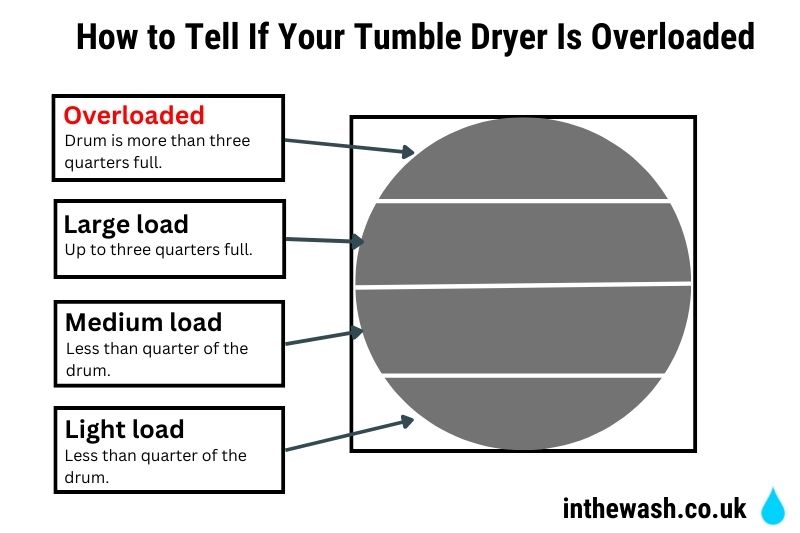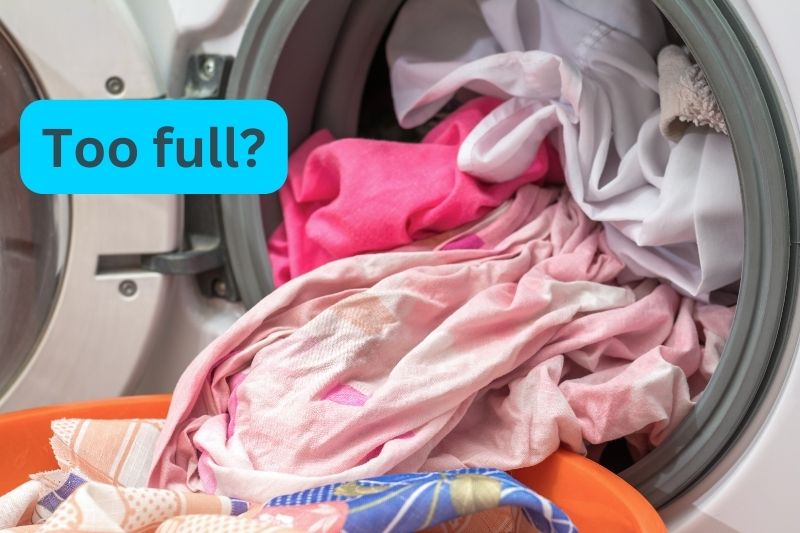Tumble dryers make the whole process of washing and drying clothes so much easier.
However, if your tumble dryer often leaves your clothes wet after the cycle, or there is a lot of lint in your dryer after a cycle, you may be overloading it.
Below, we’ve got a guide to loading a tumble dryer correctly and an explanation of the dangers of overloading a tumble dryer.
While some of these dangers cause minor inconveniences to your washing routine, others can be very costly.
How to Tell If a Dryer Is Overloaded
Clothes should be allowed to tumble freely in a dryer. This ensures that the fabric can relax and that the warm air can pass through all the items as quickly as possible and expel the moisture in the fabric.
So, here is a general guide to loading a tumble dryer:
- Light load: This could be 3-4 items, but nothing more than a quarter of the drum.
- Medium load: filling the drum to no more than halfway.
- Large load: The largest load recommended in most tumble dryers is filling the drum to three-quarters full.
- Overloaded: The drum is more than three-quarters full.
Anything more than three-quarters full, and you are overloading your tumble dryer. But what happens if you overload a dryer?

What Happens If You Overload a Tumble Dryer?
Overloading a tumble dryer can lead to some minor inconveniences and some major issues that we’ll get to in just a moment.
The minor inconveniences of overloading a tumble dryer include the following.
Wrinkles
Overloading a tumble dryer can cause your clothes to have a lot more wrinkles when you take them out because they haven’t had space in the dryer to relax. This will result in more ironing, and no one wants more ironing to do!
Lint on clothes
All clothes have fluff and hair on them, and the more clothes you pile into your tumble dryer, the more lint you can expect to find.
While most tumble dryers have a lint catcher, if the tumble dryer is too overloaded, the lint may not be able to escape from the pile of clothes. So, the lint will be all over your clothes when you remove them from the dryer.
Longer drying times
The more clothes you add to the dryer, the more moisture there is to remove. So, with big loads of wet clothes, you’ll be waiting for longer for them to dry.
By making sure loads aren’t too big, the clothes have space to spread out and allow the warm air to get rid of the moisture.
Higher energy bills
If your tumble dryer takes longer to dry each load because it is overloaded, this will result in higher energy bills per load as you’ll need several cycles to get them dry.
Several small loads take less time to dry and use less energy as a result.
Can You Break a Tumble Dryer by Overloading It?
The biggest problem with overloading your tumble dryer is the risk of it breaking. One or two large loads in the lifetime of a dryer may not do any damage. However, consistently adding too many clothes to your dryer can result in a breakdown.
This is because the dryer has to work much harder than usual to dry the clothes.
Wet clothes are extremely heavy, and the motors in the machine need to turn the drum with that weight.
Over time, you can damage the motors of a tumble dryer if they are overworked.
This can result in a hefty repair bill, or you may need to buy a new tumble dryer if you cannot find replacement parts for your particular tumble dryer.
In Conclusion
By making sure you don’t fill your tumble dryer more than three quarters full, you can enjoy lint-free, wrinkle-free clothes that dry much quicker.
You’ll prolong the life of your tumble dryer too, and you may notice some savings on your energy bills as well.
Don’t forget, In The Wash has loads of tumble dryer articles just like this one, as well as the best tumble dryers available in the UK right now too.
So, if you’d like to replace your tumble dryer after overloading it one too many times or want to find out what a heat pump dryer is, In The Wash is the place to be.

In The Wash is your guide to the best laundry and cleaning products, tips and tricks. Our mission is to solve the UK’s cleaning and laundry dilemmas!






